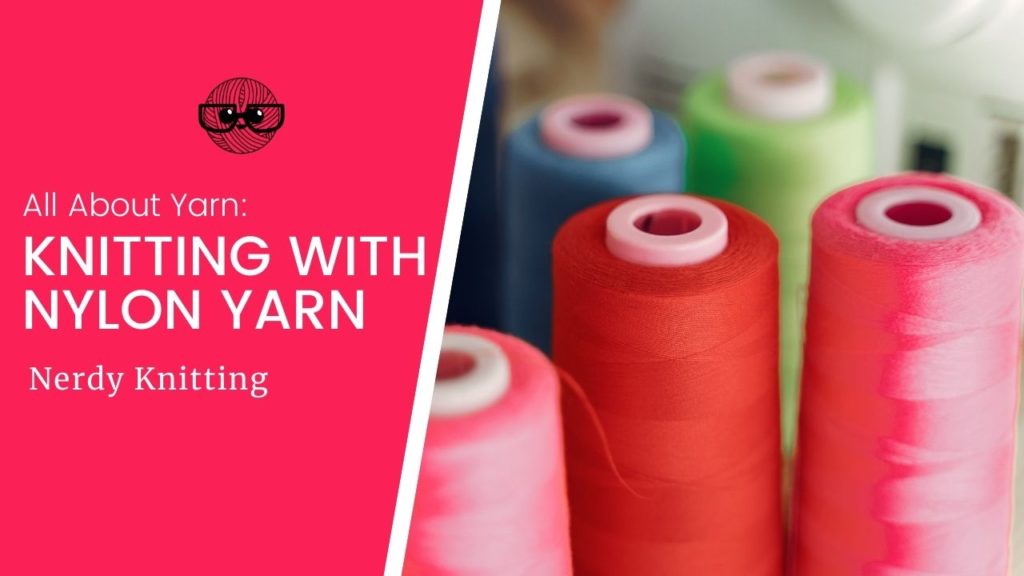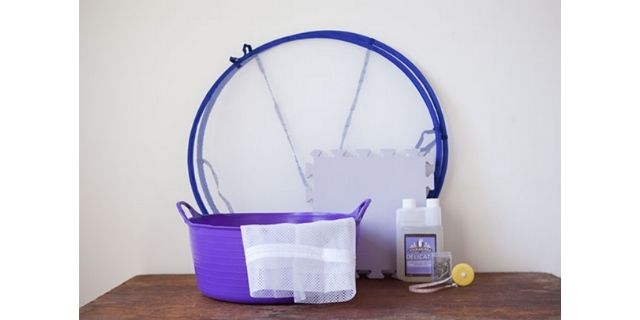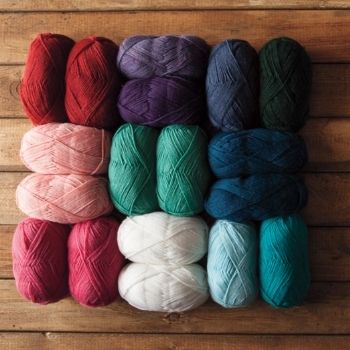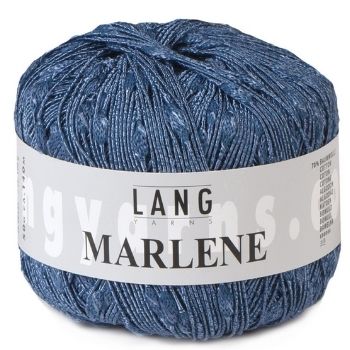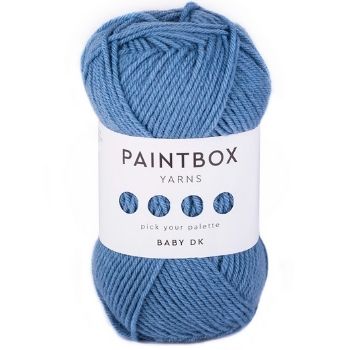Nylon is often found in yarns for knitting patterns and projects, but why exactly is it included? There are a few reasons you’ll find nylon added to your favorite yarns. In this article we’ll look at knitting with nylon – why it’s included in yarn and what purpose it serves.
The main purpose for adding nylon is its ability to ‘help’ other fibers – it can add strength and durability to other fibers. We’ll explore this topic and more below.
Some links below are affiliate links. If you click through and make a purchase I may receive a small commission at no extra cost to you. See the disclosure policy for more information.
#1. What is nylon yarn?
Nylon is a man-made polyamide fiber that was invented before World War II and went on to be used in many different things, including women’s nylon stockings. In knitting, nylon is often included in yarns to add additional strength, elasticity, and durability but can be spun and put into 100% nylon yarns as well. It is commonly used in novelty yarns.
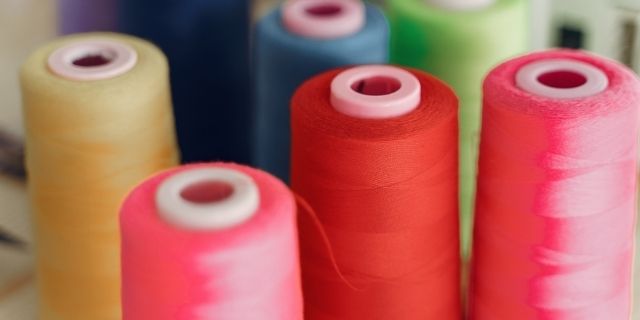
#2. What is nylon yarn used for?
Nylon is often included in small amounts in yarn because it adds strength, elasticity, and durability – something that is desirable in many yarns, especially delicate or inelastic fibers. In this case, nylon isn’t the star of the show, it simply helps out other fibers and makes the yarns more useful for a wider variety of knitting projects.
Nylon is also commonly used to create novelty yarns because it can provide a strong core for the yarn as well as be spun into a variety of lengths and textures.
#3. What is polyamide yarn?
Polyamide yarn is the generic term for nylon. Nylon is the original Dupont brand name for polyamide fiber and has replaced polyamide as the generic term used for this type of synthetic fiber. The terms are often used interchangeably on yarn labels – you may see polyamide or nylon listed, but they are the same thing.
#4. What are the advantages of nylon?
Nylon is very strong (it’s the strongest textile fiber), lightweight, durable, and elastic. It’s often blended with other fibers to add those advantages to the yarn. Nylon is often included in sock yarns to add extra durability to hand-knit socks.
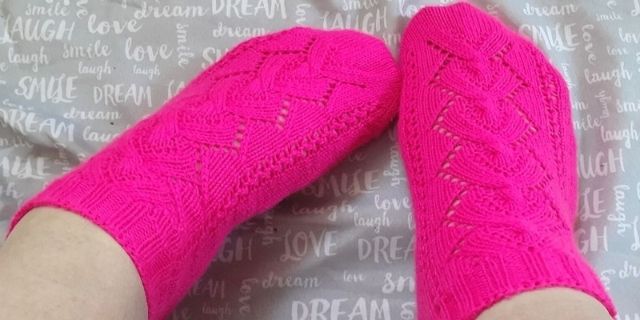
#5. What are the disadvantages of nylon?
Nylon is heat sensitive and may melt if it comes into direct contact with an iron, flame, or is put into a dryer on a high-heat setting.
# 6. How is nylon yarn made?
Like all synthetic, man-made yarns, the process begins by mixing the various components in a liquid form. This thick liquid is forced through a spinneret with various sizes of holes (the diameter of the holes determines the circumference of the filaments). The liquid congeals and forms long filament threads. These threads can then be added to other fibers and spun into useable yarn.
Alternatively, the nylon threads can be cut into staple lengths and treated just like fiber and be spun into 100% nylon yarns.
#7. What type of fiber is nylon?
Nylon is a man-made synthetic fiber. All fibers for yarn can be divided into four broad categories – animal fibers (like wool, silk, and alpaca), plant fibers (like cotton and linen), biosynthetic fibers (like rayon and bamboo), and synthetic fibers (like acrylic and nylon). Nylon fall within the synthetic fibers category because it is a chemically-derived product that goes through a synthetic process to become a useable fiber.
#8. How do you care for nylon?
Nylon is easy to care for – it is machine-washable and can be put in the dryer. Because nylon is often used in a blend with other fibers, the care needs for those fibers dictate how the final yarn should be cared for. Check the yarn label for appropriate care instructions for your yarn.
Nylon Yarns for Knitting
Now that we’ve discussed the most common questions about nylon, let’s look at a few yarns that include this man-made fiber. It is often included in sock yarns for its additional strength and durability. It’s commonly used in novelty yarns to give it some basic structure. You won’t often find large amounts of nylon in a yarn – it’s generally used sparingly.
Sock Yarns
Nylon is commonly used in sock and fingering-weight yarns – specifically for its strength and durability. If you’ve ever worn hand-knit socks and had them start wearing out, you may have noticed that, while the other fibers have deteriorated, the nylon still forms a mesh-like appearance in that worn location.
Here are a few recommendations for sock yarns that include nylon:
- Knit Picks Stroll
- Debbie Bliss Toast 4 Ply
- Regia 6 Ply Color
- Cascade Heritage Solids
- West Yorkshire Spinners Signature 4 Ply
Animal Fiber & Nylon Blends
Nylon can often be included with animal fibers. Sometimes it’s added to wool (especially for yarns that need additional durability, like sock yarn) but also with other animal fibers that aren’t as strong or elastic as wool.
Here are a few animal-fiber yarns that include nylon:
- Knit Picks Wonderfluff (baby alpaca, merino wool & nylon)
- Knit Picks Biggo (superwash merino wool & nylon)
- Lang Yarns Cara (silk & nylon)
- Juniper Moon Farm Stratus (wool, nylon, alpaca & yak)
- Rowan Camello (wool, camel & nylon)
Plant Fiber & Nylon Blends
Nylon is also included in many plant-fiber yarns like cotton. While cotton is certainly strong and durable, it does not have any natural memory (that’s why cotton drops and sags with time). The addition of nylon gives a cotton yarn some of that needed memory to help cotton garments better hold their shape. Nylon is often included in novelty yarn blends as you’ll see in some of the yarns here.
Here are a few cotton (and other plant based yarns) that use nylon:
- Knit Picks Snuggle Puff (Pima Cotton & nylon)
- Berroco Liana (linen & nylon)
- Lang Yarns Marlene (cotton & nylon)
- Berroco Zinnia (cotton & nylon)
- Lang Yarns Velluto (viscose & nylon)
Acrylic & Nylon Blends
Acrylic yarns often include nylon as well for additional softness, strength, and durability. These are generally very easy maintenance yarns that can be machine washed and dried so you’ll often see this blend used in yarns that are marketed for baby items. Here are a few examples of acrylic-nylon yarns:
Now you know why nylon is added to yarn and what makes it such a great addition! Here are more resources and articles that you might find useful – especially if you’re interested in learning more about other fibers and yarns.
More About Yarns & Fibers
- The Knitter’s Book of Yarn by Clara Parkes (available at Amazon)
- Yarn Substitution Made Easy by Carol J. Sulcoski (available at Amazon)
- The Fleece & Fiber Sourcebook by Carol Ekarius & Deborah Robson (available at Amazon)
